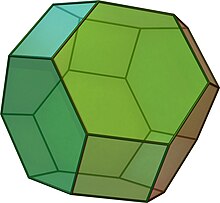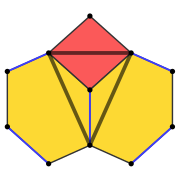In geometry, the truncated octahedron is the Archimedean solid that arises from a regular octahedron by removing six pyramids, one at each of the octahedron's vertices. The truncated octahedron has 14 faces (8 regular hexagons and 6 squares), 36 edges, and 24 vertices. Since each of its faces has point symmetry the truncated octahedron is a 6-zonohedron. It is also the Goldberg polyhedron GIV(1,1), containing square and hexagonal faces. Like the cube, it can tessellate (or "pack") 3-dimensional space, as a permutohedron.
The truncated octahedron was called the "mecon" by Buckminster Fuller.
Its dual polyhedron is the tetrakis hexahedron. If the original truncated octahedron has unit edge length, its dual tetrakis hexahedron has edge lengths 9/8√2 and 3/2√2.
Classifications
As an Archimedean solid
A truncated octahedron is constructed from a regular octahedron by cutting off all vertices. This resulting polyhedron has six squares and eight hexagons, leaving out six square pyramids. Considering that each length of the regular octahedron is , and the edge length of a square pyramid is (the square pyramid is an equilateral, the first Johnson solid). From the equilateral square pyramid's property, its volume is . Because six equilateral square pyramids are removed by truncation, the volume of a truncated octahedron is obtained by subtracting the volume of a regular octahedron from those six: The surface area of a truncated octahedron can be obtained by summing all polygonals' area, six squares and eight hexagons. Considering the edge length , this is:

The truncated octahedron is one of the thirteen Archimedean solids. In other words, it has a highly symmetric and semi-regular polyhedron with two or more different regular polygonal faces that meet in a vertex. The dual polyhedron of a truncated octahedron is the tetrakis hexahedron. They both have the same three-dimensional symmetry group as the regular octahedron does, the octahedral symmetry . A square and two hexagons surround each of its vertex, denoting its vertex figure as .
The dihedral angle of a truncated octahedron between square-to-hexagon is , and that between adjacent hexagonal faces is .
The Cartesian coordinates of the vertices of a truncated octahedron with edge length 1 are all permutations of
As a space-filling polyhedron
 Truncated octahedron as a permutahedron of order 4
Truncated octahedron as a permutahedron of order 4 Truncated octahedra tiling space
Truncated octahedra tiling space
The truncated octahedron can be described as a permutohedron of order 4 or 4-permutohedron, meaning it can be represented with even more symmetric coordinates in four dimensions: all permutations of form the vertices of a truncated octahedron in the three-dimensional subspace . Therefore, each vertex corresponds to a permutation of and each edge represents a single pairwise swap of two elements. It has the symmetric group .
The truncated octahedron can tile space. It is classified as plesiohedron, meaning it can be defined as the Voronoi cell of a symmetric Delone set. Plesiohedra, translated without rotating, can be repeated to fill space. There are five three-dimensional primary parallelohedrons, one of which is the truncated octahedron. More generally, every permutohedron and parallelohedron is a zonohedron, a polyhedron that is centrally symmetric and can be defined by a Minkowski sum.
Applications
 The structure of the faujasite framework
The structure of the faujasite framework First Brillouin zone of FCC lattice, showing symmetry labels for high symmetry lines and points.
First Brillouin zone of FCC lattice, showing symmetry labels for high symmetry lines and points.
In chemistry, the truncated octahedron is the sodalite cage structure in the framework of a faujasite-type of zeolite crystals.
In solid-state physics, the first Brillouin zone of the face-centered cubic lattice is a truncated octahedron.
The truncated octahedron (in fact, the generalized truncated octahedron) appears in the error analysis of quantization index modulation (QIM) in conjunction with repetition coding.
Dissection
The truncated octahedron can be dissected into a central octahedron, surrounded by 8 triangular cupolae on each face, and 6 square pyramids above the vertices.

 Second and third genus toroids
Second and third genus toroids
Removing the central octahedron and 2 or 4 triangular cupolae creates two Stewart toroids, with dihedral and tetrahedral symmetry:
It is possible to slice a tesseract by a hyperplane so that its sliced cross-section is a truncated octahedron.
The cell-transitive bitruncated cubic honeycomb can also be seen as the Voronoi tessellation of the body-centered cubic lattice. The truncated octahedron is one of five three-dimensional primary parallelohedra.
Objects

 Jungle gym nets often include truncated octahedra.
Jungle gym nets often include truncated octahedra.
-
 ancient Chinese die
ancient Chinese die
-
 sculpture in Bonn
sculpture in Bonn
-
 Rubik's Cube variant
Rubik's Cube variant
-
 model made with Polydron construction set
model made with Polydron construction set
-
 Pyrite crystal
Pyrite crystal
-
 Boleite crystal
Boleite crystal
Truncated octahedral graph
| Truncated octahedral graph | |
|---|---|
 3-fold symmetric Schlegel diagram 3-fold symmetric Schlegel diagram | |
| Vertices | 24 |
| Edges | 36 |
| Automorphisms | 48 |
| Chromatic number | 2 |
| Book thickness | 3 |
| Queue number | 2 |
| Properties | Cubic, Hamiltonian, regular, zero-symmetric |
| Table of graphs and parameters | |
In the mathematical field of graph theory, a truncated octahedral graph is the graph of vertices and edges of the truncated octahedron. It has 24 vertices and 36 edges, and is a cubic Archimedean graph. It has book thickness 3 and queue number 2.
As a Hamiltonian cubic graph, it can be represented by LCF notation in multiple ways: , , and .

References
- "Truncated Octahedron". Wolfram Mathworld.
- ^ Berman, Martin (1971). "Regular-faced convex polyhedra". Journal of the Franklin Institute. 291 (5): 329–352. doi:10.1016/0016-0032(71)90071-8. MR 0290245.
- Diudea, M. V. (2018). Multi-shell Polyhedral Clusters. Carbon Materials: Chemistry and Physics. Vol. 10. Springer. p. 39. doi:10.1007/978-3-319-64123-2. ISBN 978-3-319-64123-2.
- Koca, M.; Koca, N. O. (2013). "Coxeter groups, quaternions, symmetries of polyhedra and 4D polytopes". Mathematical Physics: Proceedings of the 13th Regional Conference, Antalya, Turkey, 27–31 October 2010. World Scientific. p. 48.
- Williams, Robert (1979). The Geometrical Foundation of Natural Structure: A Source Book of Design. Dover Publications, Inc. p. 78. ISBN 978-0-486-23729-9.
- Johnson, Norman W. (1966). "Convex polyhedra with regular faces". Canadian Journal of Mathematics. 18: 169–200. doi:10.4153/cjm-1966-021-8. MR 0185507. S2CID 122006114. Zbl 0132.14603.
- Johnson, Tom; Jedrzejewski, Franck (2014). Looking at Numbers. Springer. p. 15. doi:10.1007/978-3-0348-0554-4. ISBN 978-3-0348-0554-4.
- Crisman, Karl-Dieter (2011). "The Symmetry Group of the Permutahedron". The College Mathematics Journal. 42 (2): 135–139. doi:10.4169/college.math.j.42.2.135. JSTOR college.math.j.42.2.135.
- Erdahl, R. M. (1999). "Zonotopes, dicings, and Voronoi's conjecture on parallelohedra". European Journal of Combinatorics. 20 (6): 527–549. doi:10.1006/eujc.1999.0294. MR 1703597.. Voronoi conjectured that all tilings of higher dimensional spaces by translates of a single convex polytope are combinatorially equivalent to Voronoi tilings, and Erdahl proves this in the special case of zonotopes. But as he writes (p. 429), Voronoi's conjecture for dimensions at most four was already proven by Delaunay. For the classification of three-dimensional parallelohedra into these five types, see Grünbaum, Branko; Shephard, G. C. (1980). "Tilings with congruent tiles". Bulletin of the American Mathematical Society. New Series. 3 (3): 951–973. doi:10.1090/S0273-0979-1980-14827-2. MR 0585178.
- Alexandrov, A. D. (2005). "8.1 Parallelohedra". Convex Polyhedra. Springer. pp. 349–359.
- Jensen, Patrick M.; Trinderup, Camilia H.; Dahl, Anders B.; Dahl, Vedrana A. (2019). "Zonohedral Approximation of Spherical Structuring Element for Volumetric Morphology". In Felsberg, Michael; Forssén, Per-Erik; Sintorn, Ida-Maria; Unger, Jonas (eds.). Image Analysis: 21st Scandinavian Conference, SCIA 2019, Norrköping, Sweden, June 11–13, 2019, Proceedings. Springer. p. 131–132. doi:10.1007/978-3-030-20205-7. ISBN 978-3-030-20205-7.
- Yen, Teh F. (2007). Chemical Processes for Environmental Engineering. Imperial College Press. p. 338. ISBN 978-1-86094-759-9.
- Mizutani, Uichiro (2001). Introduction to the Electron Theory of Metals. Cambridge University Press. p. 112. ISBN 978-0-521-58709-9.
- Perez-Gonzalez, F.; Balado, F.; Martin, J.R.H. (2003). "Performance analysis of existing and new methods for data hiding with known-host information in additive channels". IEEE Transactions on Signal Processing. 51 (4): 960–980. Bibcode:2003ITSP...51..960P. doi:10.1109/TSP.2003.809368.
- Doskey, Alex. "Adventures Among the Toroids – Chapter 5 – Simplest (R)(A)(Q)(T) Toroids of genus p=1". www.doskey.com.
- Borovik, Alexandre V.; Borovik, Anna (2010), "Exercise 14.4", Mirrors and Reflections, Universitext, New York: Springer, p. 109, doi:10.1007/978-0-387-79066-4, ISBN 978-0-387-79065-7, MR 2561378
- Read, R. C.; Wilson, R. J. (1998), An Atlas of Graphs, Oxford University Press, p. 269
- Wolz, Jessica; Engineering Linear Layouts with SAT. Master Thesis, University of Tübingen, 2018
- Weisstein, Eric W. "Truncated octahedral graph". MathWorld.
- Williams, Robert (1979). The Geometrical Foundation of Natural Structure: A Source Book of Design. Dover Publications, Inc. ISBN 0-486-23729-X. (Section 3–9)
- Freitas, Robert A. Jr (1999). "Figure 5.5: Uniform space-filling using only truncated octahedra". Nanomedicine, Volume I: Basic Capabilities. Georgetown, Texas: Landes Bioscience. Retrieved 2006-09-08.
- Gaiha, P. & Guha, S.K. (1977). "Adjacent vertices on a permutohedron". SIAM Journal on Applied Mathematics. 32 (2): 323–327. doi:10.1137/0132025.
- Hart, George W. "VRML model of truncated octahedron". Virtual Polyhedra: The Encyclopedia of Polyhedra. Retrieved 2006-09-08.
- Mäder, Roman. "The Uniform Polyhedra: Truncated Octahedron". Retrieved 2006-09-08.
- Alexandrov, A.D. (1958). Konvexe Polyeder. Berlin: Springer. p. 539. ISBN 3-540-23158-7.
- Cromwell, P. (1997). Polyhedra. United Kingdom: Cambridge. pp. 79–86 Archimedean solids. ISBN 0-521-55432-2.
External links
- Weisstein, Eric W., "Truncated octahedron" ("Archimedean solid") at MathWorld.
- Weisstein, Eric W. "Permutohedron". MathWorld.
- Klitzing, Richard. "3D convex uniform polyhedra x3x4o - toe".
- Editable printable net of a truncated octahedron with interactive 3D view
| Convex polyhedra | |||||
|---|---|---|---|---|---|
| Platonic solids (regular) | |||||
| Archimedean solids (semiregular or uniform) | |||||
| Catalan solids (duals of Archimedean) |
| ||||
| Dihedral regular | |||||
| Dihedral uniform |
| ||||
| Dihedral others | |||||
| Degenerate polyhedra are in italics. | |||||




 , and the edge length of a square pyramid is
, and the edge length of a square pyramid is  (the square pyramid is an
(the square pyramid is an  . Because six equilateral square pyramids are removed by truncation, the volume of a truncated octahedron
. Because six equilateral square pyramids are removed by truncation, the volume of a truncated octahedron  is obtained by subtracting the volume of a regular octahedron from those six:
is obtained by subtracting the volume of a regular octahedron from those six:
 The surface area of a truncated octahedron can be obtained by summing all polygonals' area, six squares and eight hexagons. Considering the edge length
The surface area of a truncated octahedron can be obtained by summing all polygonals' area, six squares and eight hexagons. Considering the edge length 
 .
.
 , and that between adjacent hexagonal faces is
, and that between adjacent hexagonal faces is  .
.

 form the vertices of a truncated octahedron in the three-dimensional subspace
form the vertices of a truncated octahedron in the three-dimensional subspace  . Therefore, each vertex corresponds to a permutation of
. Therefore, each vertex corresponds to a permutation of  .
.














